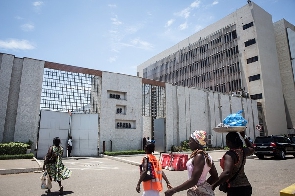A new banking sector report (March 2020) published by the Bank of Ghana has shown that more than half of banks’ deposits mobilised between February 2019 and February 2020 went into loans, an indication that banks are living up to their mandate of supporting the private sector with access to capital to expand.
The report indicates that the banking industry’s loan-to-deposits (gross loans to total deposits), which is a key measure of financial intermediation, increased to 55 percent from 51 percent within the stated period.
This resulted in growth in total borrowings outpacing growth in deposits, leading banks to rely on additional borrowings to support their credit expansion. Correspondingly, total borrowings increased by 30.7 percent compared with a decline of 6.3 percent in February 2019; whereas the share of deposits dipped to 64.8 percent from 66 percent over the two corresponding periods.
Commenting on this, professor of finance at the University of Cape Coast, Prof. John Gatsi, said it is a welcoming news as it is an indication that banks are living up to their mandate of developing the private sector through loans.
“The main job of banks is to do financial intermediation, thus take deposits and transform it into loans. So it means that in terms of the financial intermediation they are improving in transforming deposits into loans for the economy.
And if more of these loans are given to the private sector, then it means that more deposits are being transformed into loans for the private sector, which is why banks are set up, and that is a good thing,” he said in an interview with the B&FT.
Another impressive news in the report is the astronomical rise in gross loans and advances. It increased by 26 percent to hit GH¢45.91 billion in February 2020, as against the marginal growth of 1.9 percent during same period in 2019. The private sector credit also recorded a stellar jump, growing by 21 percent to hit GH¢40.05 billion, against a weak growth of 4.1 percent same period in 2019.
A further breakdown of private sector credit shows that indigenous enterprises remain the largest recipient of total industry credit. The services sector dominated with the highest share of credit, followed by the commerce and finance sector, and the manufacturing sector. These three sectors accounted for 52.5 percent of total credit.
When further disaggregated, their respective shares were 24.6 percent, 20.8 percent, and 10.6 percent as at end February 2020. The other economic sectors accounted for the remaining 47.5 percent in various proportions. The mining and quarrying sector remained the lowest recipient of industry credit with a share of 2.7 percent.
However, this does not mean the loans are coming cheap anyway, as the Summary of Economic and Financial data released earlier by the central bank indicates lending rates are still sticky downwards.
Coronavirus effect on credit
The credit conditions survey in the report, however, revealed that banks will tighten their credit stance on loans to enterprises and households in the two months ahead due to the impact of the coronavirus pandemic on the sector.
Business News of Thursday, 30 April 2020
Source: thebftonline.com

















